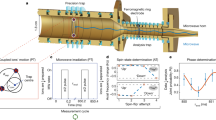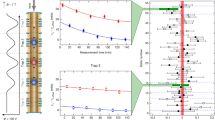Abstract
One of the fundamental properties of the proton is its magnetic moment, µp. So far µp has been measured only indirectly, by analysing the spectrum of an atomic hydrogen maser in a magnetic field1. Here we report the direct high-precision measurement of the magnetic moment of a single proton using the double Penning-trap technique2. We drive proton-spin quantum jumps by a magnetic radio-frequency field in a Penning trap with a homogeneous magnetic field. The induced spin transitions are detected in a second trap with a strong superimposed magnetic inhomogeneity3. This enables the measurement of the spin-flip probability as a function of the drive frequency. In each measurement the proton’s cyclotron frequency is used to determine the magnetic field of the trap. From the normalized resonance curve, we extract the particle’s magnetic moment in terms of the nuclear magneton: μp = 2.792847350(9)μN. This measurement outperforms previous Penning-trap measurements4,5 in terms of precision by a factor of about 760. It improves the precision of the forty-year-old indirect measurement, in which significant theoretical bound state corrections6 were required to obtain µp, by a factor of 3. By application of this method to the antiproton magnetic moment, the fractional precision of the recently reported value7 can be improved by a factor of at least 1,000. Combined with the present result, this will provide a stringent test of matter/antimatter symmetry with baryons8.
This is a preview of subscription content, access via your institution
Access options
Subscribe to this journal
Receive 51 print issues and online access
$199.00 per year
only $3.90 per issue
Buy this article
- Purchase on Springer Link
- Instant access to full article PDF
Prices may be subject to local taxes which are calculated during checkout



Similar content being viewed by others
References
Winkler, P. F., Kleppner, D., Myint, T. & Walther, F. G. Magnetic moment of the proton in Bohr magnetons. Phys. Rev. A 5, 83–114 (1972)
Häffner, H. et al. Double Penning-trap technique for precise g-factor determinations in highly charged ions. Eur. Phys. J. D 22, 163–182 (2003)
Dehmelt, H. G. & Ekström, P. Proposed g-2 experiment on single stored electron or positron. Bull. Am. Phys. Soc. 18, 727–731 (1973)
Rodegheri, C. C. et al. An experiment for the direct determination of the g-factor of a single proton in a Penning trap. New J. Phys. 14, 063011 (2012)
DiSciacca, J. & Gabrielse, G. Direct measurement of the proton magnetic moment. Phys. Rev. Lett. 108, 153001 (2012)
Karshenboim, S. G. & Ivanov, V. G. The g-factor of the proton. Phys. Lett. B 566, 27–34 (2003)
DiSciacca, J. et al. One-particle measurement of the antiproton magnetic moment. Phys. Rev. Lett. 110, 130801 (2013)
Bluhm, R., Kostelecký, V. A. & Russell, N. CPT and Lorentz tests in Penning traps. Phys. Rev. D 57, 3932–3943 (1998)
Beringer, J. et al. (Particle Data Group). Review of particle physics. Phys. Rev. D 86, 010001 (2012)
Van Dyck, R. S., Jr, Farnham, D. L., Zafonte, S. L. & Schwinberg, P. B. High precision Penning trap mass spectroscopy and a new measurement of the proton’s “atomic mass”. AIP Conf. Proc. 457, 101–110 (1999)
Sturm, S. et al. High-precision measurement of the atomic mass of the electron. Nature 506, 467–470 (2014)
Pohl, R. et al. The size of the proton. Nature 466, 213–216 (2010)
Van Dyck, R. S., Schwinberg, P. B. & Dehmelt, H. G. New high-precision comparison of electron and positron g-factors. Phys. Rev. Lett. 59, 26–29 (1987)
Hanneke, D., Fogwell, S. & Gabrielse, G. New measurement of the electron magnetic moment and the fine structure constant. Phys. Rev. Lett. 100, 120801 (2008)
Brown, L. S. & Gabrielse, G. Geonium theory: physics of a single electron or ion in a Penning trap. Rev. Mod. Phys. 58, 233–311 (1986)
Brown, L. S. Geonium lineshape. Ann. Phys. 159, 62–98 (1985)
Ulmer, S. et al. Observation of spin flips with a single trapped proton. Phys. Rev. Lett. 106, 253001 (2011)
Gabrielse, G. et al. Special relativity and the single antiproton: fortyfold improved comparison of and p charge-to-mass ratios. Phys. Rev. Lett. 74, 3544–3547 (1995)
Ulmer, S. et al. Direct measurement of the free cyclotron frequency of a single particle in a Penning trap. Phys. Rev. Lett. 107, 103002 (2011)
Ulmer, S. et al. A cryogenic detection system at 28.9 MHz for the non-destructive observation of a single proton at low particle energy. Nucl. Instrum. Meth. A 705, 55–60 (2013)
Wineland, D. J. & Dehmelt, H. G. Principles of the stored ion calorimeter. J. Appl. Phys. 46, 919–930 (1975)
Mooser, A. et al. Demonstration of the double Penning-trap technique with a single proton. Phys. Lett. B 723, 78–81 (2013)
Mooser, A. et al. Resolution of single spin-flips of a single proton. Phys. Rev. Lett. 110, 140405 (2013)
DiSciacca, J., Marshall, M., Marable, K. & Gabrielse, G. Resolving an individual one-proton spin flip to determine a proton spin state. Phys. Rev. Lett. 110, 140406 (2013)
Cornell, E. A., Weisskoff, R. M., Boyce, K. R. & Pritchard, D. E. Mode coupling in a Penning trap: π pulses and a classical avoided crossing. Phys. Rev. A 41, 312–315 (1990)
Sivia, D. S. & Skilling J Data Analysis—A Bayesian Tutorial 1st edn (Oxford Science, 2010)
Sturm, S. et al. g-factor measurement of hydrogenlike 28Si13+ as a challenge to QED calculations. Phys. Rev. A 87, 030501 (2013)
Mittleman, R. K., Ioannou, I. I., Dehmelt, H. G. & Russell, N. Bound on CPT and Lorentz symmetry with a trapped electron. Phys. Rev. Lett. 83, 2116–2119 (1999)
Smorra, C. et al. Towards a high-precision measurement of the antiproton magnetic moment. Hyperfine Interact. http://dx.doi.org/10.1007/s10751-014-1018-7 (2014)
Ulmer, S. et al. Technical Design Report BASE CERN Document Server, SPSC-TDR-002, http://cds.cern.ch/record/1503514?ln=de (CERN, 2013)
Acknowledgements
We acknowledge the financial support of the BMBF, and of the EU (ERC grant number 290870-MEFUCO), the Helmholtz-Gemeinschaft, HGS-HIRE, the Max-Planck Society, IMPRS-PTFS, and the RIKEN Initiative Research Unit Program.
Author information
Authors and Affiliations
Contributions
S.U., C.C.R., H.K., A.M. and C.L. designed and built the experimental apparatus and the data acquisition system. A.M., C.L. and S.U. took part in the months-long data-taking runs. K.F. and A.M. developed the algorithms for the spin state analysis. A.M., K.F., S.U., C.L. and H.K. analysed the data. S.U., A.M., K.B. and J.W. wrote the initial manuscript, which was then improved and approved by all authors.
Corresponding author
Ethics declarations
Competing interests
The authors declare no competing financial interests.
Rights and permissions
About this article
Cite this article
Mooser, A., Ulmer, S., Blaum, K. et al. Direct high-precision measurement of the magnetic moment of the proton. Nature 509, 596–599 (2014). https://doi.org/10.1038/nature13388
Received:
Accepted:
Published:
Issue Date:
DOI: https://doi.org/10.1038/nature13388
This article is cited by
-
Particles, fields, and the ontology of the standard model
Synthese (2023)
-
NMR Spectra of Cesium in Aqueous Solutions. Determination of the Magnetic Moment of Cesium-133 Nucleus
Measurement Techniques (2022)
-
Direct limits on the interaction of antiprotons with axion-like dark matter
Nature (2019)
-
350-fold improved measurement of the antiproton magnetic moment using a multi-trap method
Hyperfine Interactions (2018)
-
Sixfold improved single particle measurement of the magnetic moment of the antiproton
Nature Communications (2017)
Comments
By submitting a comment you agree to abide by our Terms and Community Guidelines. If you find something abusive or that does not comply with our terms or guidelines please flag it as inappropriate.



